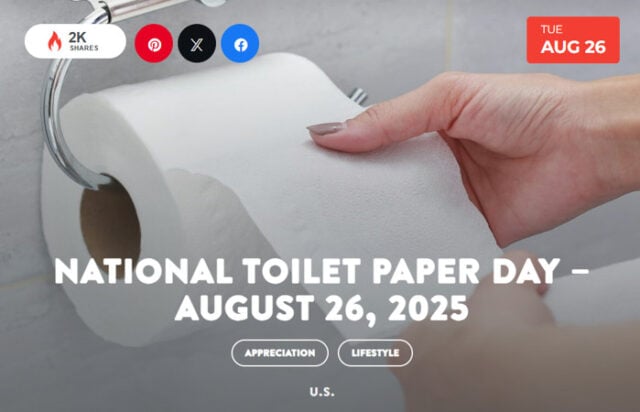
National Toilet Paper Day is observed each year on August 26. This essential item is used most by Americans followed by other countries across the globe. One of the times we realize the importance of this often-overlooked item is when we enter a public restroom and realize there is no toilet paper. Not long ago, toilet paper used to come in multiple colors. Now, many more countries are also using toilet paper along with a bidet.
Items of nature have certainly been part of the list, including leaves, corn cobs, and even sponges that were attached to a long stick and used communally.
- 1st Century AD – In the Roman world, a sponge is attached to a stick and used for communal wiping.
- 6th Century AD – Chinese Scholar official Yan Zhitui writes about not using certain books “for toilet purposes”.
- 14th Century By the 14th century, the Chinese had made advancements in toilet care, producing packages of special paper people could use in their wiping endeavors.
- 1391 – Made to meet the needs of the Emperor and his family during the Song Dynasty, this toilet paper is even perfumed.
- 18th Century – During the 18th century, when newspapers and magazines arrived on the scene in the West, these were often read and then re-purposed for use in the outhouse or Water Closet (WC).
- 19th Century – By the end of the 19th century, toilet paper began appearing in perforated rolls which made it more convenient for people to use. Companies began advertising their toilet paper as being “splinter-free”.
- 1857 – Modern-style toilet paper becomes commercially available in New York and is sold as “medicated paper for the Water Closet.
- 1871 – The first toilet paper is sold on a roll.
- 1879 – The Scott brothers founded the Scott Paper Company in 1879 and it started selling toilet paper in rolls in 1890.
- 1883 – Seth Wheeler patents rolled toilet paper and toilet paper dispensers.
- 1890 – The Scott Paper Company of Philadelphia began selling toilet paper in convenient rolls.
- 1919 – The story goes that Farmer’s Almanac began pre-drilling holes into the tops of their books in 1919, to allow people to easily hang them from the walls of their outhouses.
- 1950s – In the 1950s, colored toilet paper was popular because it was considered to be a cool decorating hack to “match” the pastel color of the toilet paper to the bathroom decor. However, it was learned that the dyes in the toilet paper were perhaps not hygienic as well as possibly harming the environment.
- 2004 – Scott removes colored toilet paper from the U.S. market, making it the last company to do so.
- Over or Under? Approximately two-thirds of Americans prefer their toilet paper to roll off the roll from the top instead of the bottom.
- If you hang your toilet paper so you can pull it from the bottom, you’re deemed to be more intelligent than someone who hangs their toilet paper and pulls it from the top.
- In many countries across the world, especially older cultures where their plumbing infrastructures are not modern, toilet paper is not flushed down the toilet. This includes places like Greece, Turkey, Beijing, Egypt, Bulgaria, Morocco, Montenegro and others. In these places, bathrooms often have special receptacles in which to place the toilet paper.
- The Chinese culture is estimated to produce at least 10 million packages of toilet paper each year!
- Believe it or not, but 75% of the world’s population doesn’t use toilet paper.
- The Sears catalog and the Farmer’s Almanac were two legendary forms of paper that eventually ended up in the toilet.
- Joseph Gayetty of New York began the production of what he called “Medicated Paper for the Water Closet”. Gayetty is credited with the invention of modern toilet paper
- Gayetty’s toilet paper was made of pure Manila hemp paper, with each sheet watermarked as “J C Gayetty N Y”.
- Originally, Gayetty marketed his product for medical purposes, as it contained aloe and was advertised as an anti-hemorrhoid product.
- Gayetty would sell his toilet paper for a dollar per 1,000 sheets. However, his product did not take off.
- One person’s lifetime usage of toilet paper, if made from virgin paper, would take around 384 trees to make! Of course, using toilet paper that has been recycled for other purposes helps to cut down on this extensively.
- Toilet paper has been made from all kinds of things, including gold. One manufacturer makes toilet paper out of 22-carat gold with one roll costing more than $1,300,000. This is the equivalent of literally flushing money down the toilet!
- About four billion people don’t use toilet paper. About 70% – 75 % of the world’s population does not use toilet paper.
- Toilet paper has secondary uses such as nose care, removing makeup, covering toilet seats, packaging material, cleaning mirrors, cleaning glasses, etc.
- Two-ply toilet paper consists of two layers of 10-thickness paper, one-ply is made of 13-thickness paper, so, two-ply is not necessarily twice the thickness.
- In an average household, the average roll of toilet paper lasts approximately five days.
- Consumers use approximately 8 – 9 sheets of paper per toilet use.
- We use an average of 57 sheets of toilet paper a day!
- Seven percent of Americans steal rolls of toilet paper in hotels or motels.
- The U.S. ranks as the top country that consumes toilet paper. Its per capita average is nearly 3 rolls per week.
- This toilet paper patent solved the debate on the proper way to hang the roll. Seth Wheeler patented rolled and perforated toilet paper on December 22, 1891. The patent’s illustration confirmed that toilet paper must go up and over.
- The average person uses 100 rolls of toilet paper per year (over 20,000 sheets).
- The daily production of toilet paper is about 83,048,116 rolls per day.
- The average toilet paper roll consists of 333 sheets.
- Bamboo Toilet Paper. Because bamboo grows so quickly, it is a sustainable, renewable resource that is eco-friendly and reduces the use of the planet’s trees. Some popular companies for bamboo TP are Reel and Tushy.
- Recycled Fiber Toilet Paper. It makes a lot of sense to make toilet paper out of fibers that have already been used for something else. One company doing this is Who Gives a Crap, which makes their recycled toilet paper completely from recycled office paper–and they offer a subscription service so families never have to worry about buying toilet paper at the store again!
- Free From Plastic Packaging. One of the concerns about toilet paper is not only the paper itself but the plastic packaging it comes in. Give up the plastic and opt to use a brand that uses paper and cardboard packaging.
- The United States uses the most amount of toilet paper in the world.
- The U.S. Army used toilet paper to camouflage its tanks during Operation Desert Storm.
- Toilet paper has been made from all kinds of things, including gold. One manufacturer makes toilet paper out of 22-carat gold with one roll costing more than $1,300,000. This is the equivalent of literally flushing money down the toilet!
Sources:
Disclaimer
The information contained in South Florida Reporter is for general information purposes only.
The South Florida Reporter assumes no responsibility for errors or omissions in the contents of the Service.
In no event shall the South Florida Reporter be liable for any special, direct, indirect, consequential, or incidental damages or any damages whatsoever, whether in an action of contract, negligence or other tort, arising out of or in connection with the use of the Service or the contents of the Service. The Company reserves the right to make additions, deletions, or modifications to the contents of the Service at any time without prior notice.
The Company does not warrant that the Service is free of viruses or other harmful components












